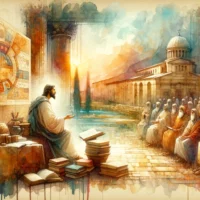Pseudepigrapha, a word that may sound foreign to many, has its roots entrenched deeply in religious history, carrying profound spiritual significance for scholars and enthusiasts alike. As we embark on this exploration, it’s important to bear in mind that the Bible, while containing the core teachings of Christianity, is but a part of the wealth of religious literature available. The pseudepigrapha, often shrouded in enigma, offers us a rich reservoir of historical, theological, and cultural context that can illuminate our comprehension of the Bible.
Defining the Pseudepigrapha
Delving into the rich tapestry of religious literature, we encounter the pseudepigrapha, a term derived from the Greek words ‘pseudo’ meaning false, and ‘epigraphein’, signifying inscriptions or superscriptions. Thus, pseudepigrapha collectively refers to works falsely ascribed to renowned biblical figures or falsely claiming to carry a certain authoritative status.
Many pseudepigraphal works bear the names of significant biblical figures such as Enoch, Abraham, Moses, and others, implying their authorship. Despite these attributions, these works were written much later and by anonymous authors whose identities remain concealed. This practice was not uncommon during antiquity, with many individuals aspiring to augment the authority and credibility of their works by associating them with revered figures.
These writings span an impressive timeframe, roughly from the 200 BCE to 300 CE, and represent a broad range of religious and philosophical thoughts existing alongside the formative stages of both Judaism and Christianity. They include a diverse assortment of materials such as testaments, apocalypses, visions, prophecies, wisdom literature, prayers, psalms, and even expansions or interpretations of biblical narratives.
In defining the pseudepigrapha, we distinguish it from other religious categories such as the canonical and deuterocanonical (or apocryphal) books. The canon refers to the books that have been universally recognized by the Church as inspired scripture, like the 66 books of the Protestant Bible or the 73 books of the Catholic Bible (2 Timothy 3:16). The deuterocanonical or apocryphal books, on the other hand, hold a disputed status between different Christian traditions, with some accepting them as part of the canon and others not. The pseudepigrapha, by contrast, are not included in any biblical canon, though they’ve often had influence on religious thought and tradition.
The term pseudepigrapha denotes religious works falsely attributed to noteworthy biblical figures to lend them authority. These writings, produced between 200 BCE and 300 CE, embrace a wide variety of genres and religious ideas. Despite bearing the names of esteemed characters, the actual authors remain anonymous. The pseudepigrapha differs from the canon, which comprises books universally accepted as inspired, and from deuterocanonical or apocryphal books, whose canonical status varies among Christian traditions. Unlike these categories, the pseudepigrapha are not included in any biblical canon, even though they have influenced religious thought and tradition.
Origins and Contents of the Pseudepigrapha
A closer look at the pseudepigrapha reveals a fascinating cross-section of ancient religious thought. These writings were conceived in a historical context marked by religious, political, and social changes. It was during the period known as the Second Temple Judaism, a crucial era between the rebuilding of the Temple in Jerusalem in 516 BCE and its destruction in 70 CE. Many of these works aimed to fill gaps or expand upon narratives found in the canonical scriptures.
One of the most recognized works of the pseudepigrapha is the Book of Enoch, traditionally ascribed to Enoch, the great-grandfather of Noah. It provides detailed accounts of heavenly realms, fallen angels, and prophecies of judgement, themes which are briefly touched on in Genesis 6:1-4. Another example is the Testament of Abraham, presenting a unique account of Abraham’s death and his tour of heaven guided by the archangel Michael.
Also worth mentioning is the Life of Adam and Eve, a work that expands on the story of Adam and Eve post-Eden. Here, we find narratives of their life, repentance, and the promise of salvation after their expulsion from Eden as briefly hinted at in Genesis 3:15. These elaborations provided early Jewish and Christian communities with answers to questions raised by the brief biblical accounts.
In terms of their geography, these writings emerged from diverse regions within the ancient Near East, including Judea, Egypt, and possibly regions like Syria and Mesopotamia. They were written primarily in Hebrew, Aramaic, and Greek, reflecting the linguistic diversity of the Jewish Diaspora.
The pseudepigrapha represent a form of literature that engaged deeply with the spiritual and theological questions of their time. They offered interpretations and elaborations on biblical narratives, addressing topics such as eschatology, angelology, and divine judgement. While these works are not part of the canonical scriptures, they provide rich insights into how early Jewish and Christian communities interacted with their faith and scriptures.
The pseudepigrapha came into existence during the period of Second Temple Judaism, expanding upon and elaborating the canonical scriptures. Notable examples include the Book of Enoch, the Testament of Abraham, and the Life of Adam and Eve, which discuss themes such as judgement, repentance, and salvation. Originating from various regions of the ancient Near East, these works were written in languages reflecting the diverse Jewish Diaspora. They engaged with critical religious questions of their time and, despite not being part of the biblical canon, offer us a window into the spiritual interactions of early Jewish and Christian communities.
The Value of the Pseudepigrapha in Modern Christian Understanding
Engaging with the pseudepigrapha can enrich our understanding of early Christian thought and provide context for the New Testament. While not recognized as inspired Scripture, these writings offer insights into the beliefs, concerns, and hopes of the early Jewish and Christian communities.
The Book of Enoch provides elaborate narratives of fallen angels and divine judgement, themes that are echoed in the New Testament (Jude 1:14-15). Understanding the detailed account in the Book of Enoch can help illuminate these New Testament references.
Another example is the Testament of the Twelve Patriarchs, ascribed to Jacob’s twelve sons. This work contains several passages that anticipate a Messiah like figure, a theme central to the New Testament’s portrayal of Jesus (Luke 24:27). Engaging with this text can provide context for the Messianic expectations present during the time of Jesus.
Pseudepigraphal texts also played a significant role in shaping Christian art, literature, and doctrine. For example, many of the details associated with the story of Adam and Eve in Christian tradition, such as the naming of the serpent as Satan, come from pseudepigraphal sources like the Life of Adam and Eve.
However, as we approach these texts, discernment is key. While they offer historical and cultural insights, they should not be seen as carrying the same authoritative weight as the canonical Scriptures in matters of faith and doctrine. We can appreciate them as historical documents that illuminate the world of the Bible and the religious imagination of ancient Jewish and Christian communities.
A thoughtful engagement with the pseudepigrapha can strengthen our biblical literacy, offer fresh perspectives on familiar biblical themes, and deepen our understanding of our Christian heritage. While maintaining the primacy of the Scriptures, we can learn from the rich tapestry of early Jewish and Christian literature that surrounds it.
The pseudepigrapha can enrich our understanding of early Christian thought and provide context for New Testament themes. Notable texts like the Book of Enoch and the Testament of the Twelve Patriarchs offer insights into themes echoed in the New Testament. They also played a role in shaping Christian tradition and doctrine. Nevertheless, discernment is key when engaging with these texts, as they should not be seen as authoritative as the Scriptures. Rather, they provide historical and cultural context and can help deepen our understanding of Christian heritage.
Navigating the Sea of Ancient Wisdom
The pseudepigrapha, while not part of the canonical scriptures, provide an invaluable perspective on the religious landscape during the formation of early Judaism and Christianity. As believers, these texts can deepen our understanding of biblical themes and the context in which our faith was born. They offer insights into the beliefs and hopes of our spiritual ancestors, illuminating the road they walked as they sought to know and honor God.
- How might the pseudepigrapha provide a fresh perspective on familiar biblical narratives or themes?
- What role do these texts play in the broader context of early Jewish and Christian literature?
- How can we exercise discernment while engaging with non-canonical religious texts?
Let’s continue to seek wisdom and grow in our faith, appreciating the vast richness of religious literature that has been passed down through the centuries. May this understanding strengthen our faith, foster humility, and ignite our passion for learning more about the remarkable depth and breadth of our Christian heritage.














